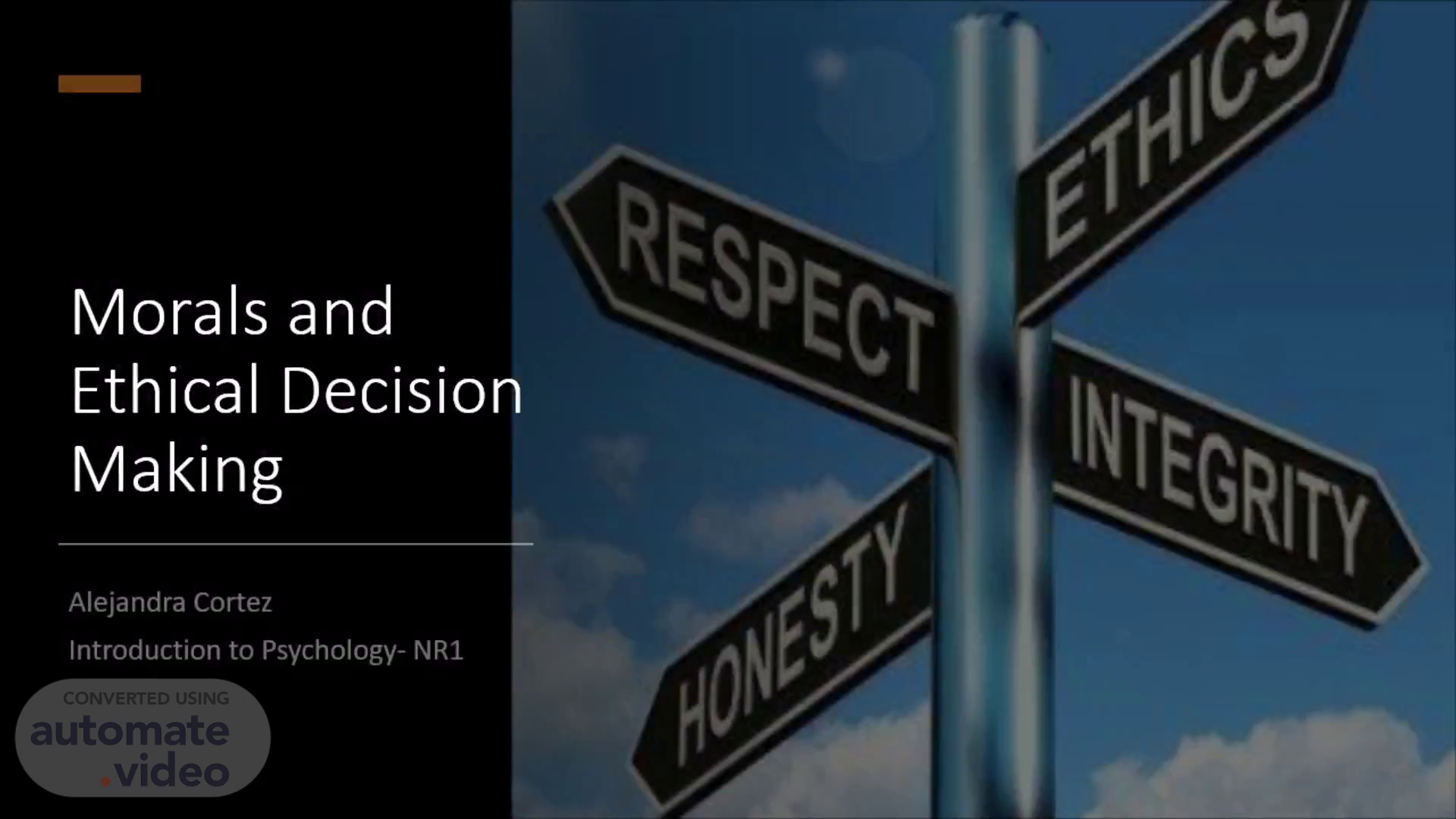
Morals and Ethical Decision Making
Scene 1 (0s)
[Audio] Morals and Ethical Decision making A. MedHub - Home | Facebook.
Scene 2 (9s)
[Audio] The world we are living in is full of biases and ethical issues that clouds our moral judgment. The moment that we acknowledge these hindrances and aim to take the right course of action is what the term "Moral Decision Making" means. It is our ability to make moral and ethical decisions, despite being tempted with various ethical biases and issues. Furthermore, according to Prentice (2023), moral decision making requires our brain's rational reasoning ability, and excludes the emotional appeal. This is because most commonly when we follow our feelings and emotion to make these decisions, we end up doing something wrong and unjust. This is because of our self-serving bias that darkens our thinking. A.
Scene 3 (55s)
[Audio] Everyone is affected and should be concerned about their moral decision-making process. This is because, at the end of the day, we are just humans and oftentimes we commit mistakes which are inevitable. However, a research conducted by Rajiah & Venaktaraman (2019) says that the age, experience, gender, and educational level of an individual has an influence on his/her moral decision making. Precisely, older and experienced individuals experience less ethical dilemma compared to younger and less experienced individuals. When it comes to gender, men seem to be more task-oriented while women are more relation-orientated, which significantly impacts ethical decision making.
Scene 4 (1m 44s)
[Audio] The concept of moral decision making was developed by Piaget, in which he outlined the two stages of moral cognitive development, namely heteronomy and autonomy. Heteronomy is the stage of children wherein they feel obligated to follow rules set by the adults. The next is autonomy where the children realize that the set rules are made from mutual consent and are worthy of respect. As a child advances away from egocentrism, Piaget also proposed that moral growth takes place (Garrigan et al., 2018).
Scene 5 (2m 19s)
[Audio] According to Carmona-Perera et al. (2013), emotional individuals tend to be less moral in creating their decisions. People with emotional processing issues frequently make more pragmatic decisions. This is because in terms of creating decisions and committing to them, following what guts are saying often leads to bad and unethical actions. We, humans, tend to follow things that give us arousal or pleasantness, and this may be from immoral actions. Sticking to logic and facts will help us be more just in creating decisions.
Scene 6 (2m 57s)
[Audio] Furthermore, Rest (1994) from the University of Minnesota actually developed a framework, the 4 components of ethical behavior. The first is moral sensitivity. The moral decision process should start with identifying that an ethical problem exists. This includes being aware that our decisions can impact the people around us, either positive or negative. The second is moral judgment, in which the individual should pick a course of action identified in step 1. They must carefully weigh all the pros and cons of each action, and find the best one. The next component is moral motivation. This is when the decision maker should commit to his//her decision and strictly follow through it. The last is moral character. To accomplish their aims, moral actors have to conquer active opposition, deal with exhaustion, fend off diversions, and devise complex techniques. In conclusion, people must continue a moral duty or activity in the face of challenges.
Scene 7 (4m 6s)
References. Carmona-Perera, M., Martí-García, C., Pérez-García, M., & Verdejo-García, A. (2013). Valence of emotions and moral decision-making: increased pleasantness to pleasant images and decreased unpleasantness to unpleasant images are associated with utilitarian choices in healthy adults. Frontiers in Human Neuroscience , 7 . https://doi.org/10.3389/fnhum.2013.00626 Pierce, B., & Sweeney, B. (2010). The Relationship between Demographic Variables and Ethical Decision Making of Trainee Accountants. International Journal of Auditing , 14 (1), 79–99. https://doi.org/10.1111/j.1099-1123.2009.00404.x.
Scene 8 (4m 39s)
References. Prentice, R. (2023, February 22). Being Your Best Self, Part 2: Moral Decision Making - Ethics Unwrapped . Ethics Unwrapped. Retrieved April 14, 2023, from https://ethicsunwrapped.utexas.edu/video/best-self-part-2-moral-decision-making#:~:text=Moral%20decision%20making%20is%20having,no%20options%20seem%20morally%20acceptable). Rajiah , K., & Venaktaraman , R. (2019). The effect of demographic and social factors on the decision-making of community pharmacists in ethical dilemmas. Journal of Research in Pharmacy Practice . https://doi.org/10.4103/jrpp.jrpp_19_15 Rest, J. R. (1994). Background: Theory and research. In J. R. Rest & D. Narvaez (Eds.), Moral development in the professions: Psychology and applied ethics, (pp. 1–25). Hillsdale, NJ: Lawrence Erlbaum; Rest, J. R. (1986). Moral development: Advances in research and theory. New York: Praeger.